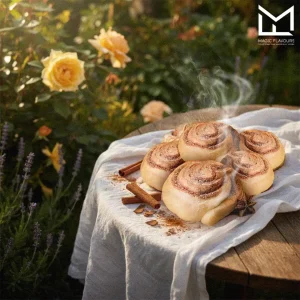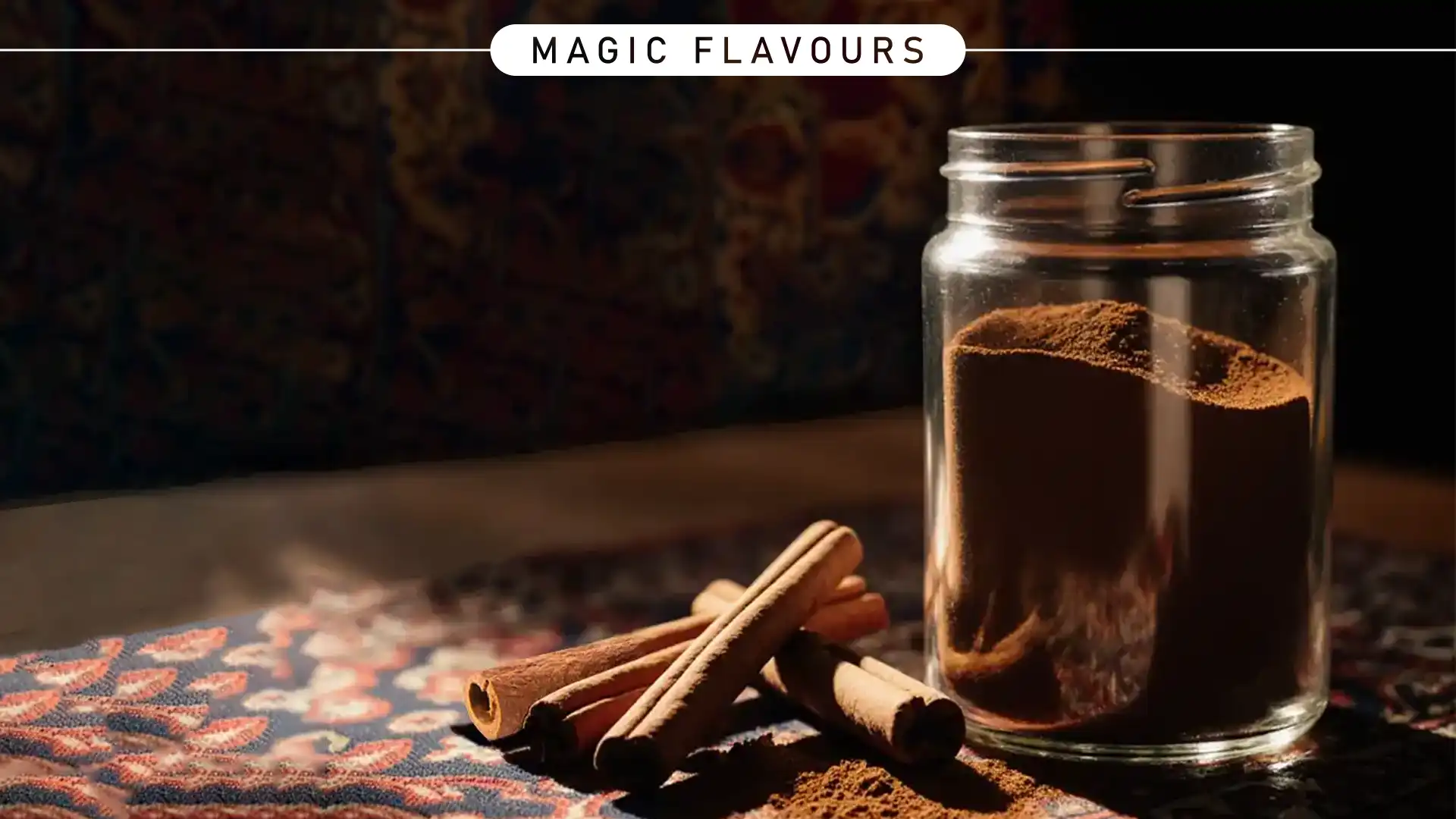1. Introduction of Cinnamon Flavor
What is cinnamon?
Cinnamon comes from the inner bark of trees in the Cinnamomum genus. Farmers harvest and dry the bark into curled sticks. These sticks are also called quills.
People grind cinnamon into powder or use it whole in cooking. It adds warmth and depth to many dishes. Because of its versatility, cinnamon appears in both sweet and savory recipes.
Cinnamon has two main types: Ceylon and Cassia. Ceylon is lighter and more delicate. Cassia is darker and stronger. Each type offers a unique flavor experience.
Why is its flavor so iconic and beloved?
Cinnamon’s flavor blends sweetness with a gentle heat, creating a balance that is both comforting and exciting. For many, it evokes feelings of home and warmth. Moreover, its aroma often triggers memories of holidays, baking, and cozy moments. Because of this, cinnamon often evokes nostalgia. That emotional link strengthens its popularity.
Cinnamon also pairs well with many ingredients. It enhances chocolate, apples, coffee, and more. This adaptability keeps it relevant across cultures and cuisines.
2. Origins and History of Cinnamon
Ancient Uses and Cultural Significance of Cinnamon Flavor

Ancient civilizations valued cinnamon for more than flavor. Historically, cinnamon has held deep cultural significance. For example, Egyptians used it in embalming and sacred rituals, believing it possessed divine properties. Similarly, in China, cinnamon appeared in medicinal texts over 4,000 years ago, where healers used it to treat colds and digestive issues. Because of its warming nature, it was considered ideal for balancing the body.
Romans considered cinnamon a luxury. They burned it during funerals to honor the dead. Because of its rarity, only the wealthy could afford it.
Trade Routes and Global Spread of Cinnamon Flavor
For centuries, Arab traders controlled the cinnamon trade, carefully keeping its source secret to protect their profits. They even told stories of giant birds guarding the trees. Over time, cinnamon traveled along ancient spice routes, eventually reaching Europe through Venice and Genoa. Demand grew quickly because of its uncommon scent and taste.
During the Age of Exploration, European powers sought direct access. Portugal and the Netherlands fought for control of cinnamon-producing regions.
Modern Cultivation and Production of Cinnamon Flavor
Today, Sri Lanka leads global cinnamon production, specializing in Ceylon cinnamon, which is prized for its delicate flavor. There, farmers harvest it by hand with great care, preserving its quality. In contrast, Indonesia produces most of the world’s Cassia cinnamon, a stronger and more economical variety that dominates commercial spice blends and packaged goods.
Other countries like India, Vietnam, and China also grow cinnamon. Each region offers unique qualities. Global demand continues to rise because of its wide uses.
3. Flavor Profile of Cinnamon
Taste Characteristics (Sweet, Spicy, Woody)
Cinnamon delivers a sweet base with a spicy kick. This contrast creates a bold and memorable flavor. It excites the palate instantly.
The spice also carries woody and earthy undertones. These notes add depth and complexity. Because of this, cinnamon complements many ingredients.
Its flavor changes slightly with heat. Cooking brings out its sweetness. Raw cinnamon tastes sharper and more intense.
Aroma and Sensory Experience of Cinnamon Flavor
Cinnamon’s aroma is warm and inviting, filling the air with comfort and familiarity. For many, it is closely associated with baked goods. In fact, the scent often triggers strong emotional responses, reminding people of holidays, family gatherings, and cozy moments. This deep connection further enhances its timeless appeal.
When you smell cinnamon, you expect sweetness. However, its spicy edge surprises you. That contrast makes the experience more dynamic.
Differences Between Ceylon and Cassia Cinnamon
Ceylon cinnamon tastes mild and citrusy. It offers subtle sweetness and delicate spice. Chefs prefer it for desserts and teas.
Cassia cinnamon is bold and pungent. It delivers strong heat and bitterness. Because of its intensity, it suits savory dishes.
Ceylon contains less coumarin, a natural compound. Cassia has more, which may pose health risks. Many people choose Ceylon for daily use.
4. Culinary Applications of Cinnamon Flavor
Cinnamon Flavor Sweet Dishes and Desserts

Cinnamon shines in sweet recipes, often used by bakers in cookies, cakes, and pastries to add warmth and depth to sugar. For example, cinnamon rolls remain a classic favorite, with their gooey texture and spicy-sweet filling creating comfort in every bite. As a result, they are loved by people all over the world.
Fruit-based desserts also benefit from cinnamon. Apples, pears, and peaches pair beautifully with its spice. This combination enhances natural sweetness.
Cinnamon Flavor Savory Recipes and Spice Blends
Cinnamon plays a key role in savory cooking, particularly in Middle Eastern and Indian dishes, where it helps balance heat and richness. Chefs often add it to stews, curries, and rice dishes to deepen flavor without overpowering other spices, making it a remarkably versatile choice. Moreover, spice blends like garam masala and Chinese five-spice commonly include cinnamon, creating complex layers of taste that consistently elevate everyday meals.
Cinnamon Flavor Beverages Featuring Cinnamon
Cinnamon enhances many drinks. People stir it into coffee, tea, and hot chocolate. It adds a cozy, aromatic twist.
Chai tea relies on cinnamon for its signature flavor. The spice blends with cardamom and ginger. Together, they create a bold brew.
Cinnamon also appears in cocktails. Bartenders use it in mulled wine and spiced rum. It brings warmth and seasonal flair to drinks.
5. Chemical Composition and Health Effects of Cinnamon Flavor
Key Flavor Compounds (Cinnamaldehyde, Eugenol)
Cinnamaldehyde gives cinnamon its signature flavor, creating the sweet-spicy taste and warm aroma that define the spice. In fact, this compound dominates much of cinnamon’s profile. Meanwhile, eugenol adds a subtle, clove-like note, appearing more prominently in Ceylon cinnamon. Together, these natural compounds shape the spice’s rich and complex character.
Both compounds offer more than flavor. They show antimicrobial and antioxidant properties. Because of this, researchers study their health potential.
Potential Health Benefits of Cinnamon Flavor
Cinnamon may help regulate blood sugar. Some studies show it improves insulin sensitivity. This makes it popular among people with diabetes.
It also contains antioxidants. These fight free radicals and reduce inflammation. Because of this, cinnamon supports overall wellness.
Cinnamon may protect heart health. It can lower cholesterol and blood pressure. However, results vary depending on dosage and type.
Risks and Recommended Intake
Cassia cinnamon contains high levels of coumarin. This compound may harm the liver in large amounts. Ceylon has much less.
Experts recommend moderate use. One teaspoon a day is generally safe. However, long-term high doses may cause problems.
Always choose quality sources. Organic and well-sourced cinnamon reduces risk. Consult a doctor before using it medicinally.
6. Cinnamon Flavor in Global Cuisines
Middle Eastern and North African Dishes
Cinnamon plays a key role in Middle Eastern cooking. It adds warmth to rice, meat, and vegetable dishes. Its sweet-spicy flavor balances bold ingredients.
In Morocco, cinnamon appears in tagines and couscous. It blends with saffron, ginger, and dried fruits. This creates rich, layered flavors.
Lebanese and Persian cuisines also use cinnamon in savory meals. It enhances stews and pilafs. Because of its depth, it complements lamb and chicken beautifully.
Asian Cuisine Highlights
Asian cuisines use cinnamon in both food and medicine. In India, cinnamon stars in curries and spice blends, and notably, garam masala often includes it. Similarly, Chinese five-spice powder contains cinnamon, adding gentle sweetness to roasted meats and stir-fries. This balance creates harmony between salty and sweet flavors. Meanwhile, Vietnamese pho uses cinnamon in its broth, giving the soup a warm, aromatic base. Ultimately, this subtle touch makes the dish truly unforgettable.
Western Baking Traditions
Western baking celebrates cinnamon, as it flavors pies, cookies, and breakfast pastries, while its warm scent fills kitchens with comfort and joy. In fact, American classics like apple pie and cinnamon rolls rely on it, and these treats feel nostalgic and indulgent. Ultimately, cinnamon ties these flavors together and makes them taste complete.
European bakers also embrace cinnamon. In Sweden, kanelbullar (cinnamon buns) are beloved. In Germany, zimtsterne (cinnamon stars) shine during holidays.
7. Psychological and Emotional Impact of Cinnamon Flavor
Comfort and Nostalgia
Cinnamon evokes comfort through its warm, familiar scent. People often link it to childhood memories and family traditions. This emotional tie strengthens its appeal.
Baked goods with cinnamon remind many of home. The aroma fills kitchens with warmth and joy. Because of this, cinnamon feels deeply personal.
Even a small whiff can trigger nostalgia. It brings back cozy mornings, festive gatherings, and quiet moments. That emotional power makes it timeless.
Seasonal Associations (Autumn, Holidays)
Cinnamon dominates autumn flavors. It appears in pumpkin spice, apple cider, and seasonal desserts. These treats mark the shift to colder days.
During holidays, cinnamon takes center stage. It flavors cookies, mulled drinks, and festive meals. Its scent fills homes with celebration.
Retailers use cinnamon in seasonal products. Candles, lotions, and air fresheners feature it. This reinforces its link to warmth and joy.
Use in Aromatherapy and Wellness
Aromatherapists use cinnamon for emotional balance. Its scent promotes relaxation and mental clarity. People often diffuse it during stressful times.
Cinnamon oil may boost mood and energy. It stimulates the senses without overwhelming them. Because of this, it suits morning routines.
Wellness brands include cinnamon in self-care products. Bath oils, scrubs, and teas feature it. These items offer comfort and a sense of grounding.
8. Cinnamon Flavor in Non-Food Products
Perfumes and Fragrances

Cinnamon adds warmth and spice to perfumes, gracefully blending with vanilla, citrus, and woody notes to create bold, sensual scents. In fact, in the world of perfumery, it’s often chosen to evoke mystery and depth, bringing a sense of sophistication and allure. Consequently, cinnamon most often shines in autumn and winter collections, where its rich and comforting character feels perfectly at home.
Because of its intensity, cinnamon works best in small doses. It enhances without overpowering. This balance makes it a favorite in niche perfumes.
Candles and Home Scents
Cinnamon dominates the home fragrance market. Candle makers use it to create cozy, seasonal blends. It pairs well with apple, clove, and nutmeg.
Diffusers and sprays also feature cinnamon. These products fill rooms with warmth and nostalgia. People use them to set a relaxing mood.
Retailers release cinnamon-scented items during holidays. These scents boost sales and create festive atmospheres. They signal comfort and celebration.
Medicinal and Cosmetic Uses
Cinnamon also appears in a variety of natural remedies. For example, its oil may help fight bacteria and reduce inflammation, which is why people often use it in balms and salves. In addition, cosmetic brands include cinnamon in lip plumpers and scrubs, as it stimulates circulation and adds a gentle tingling effect. Together, these qualities make products feel active, refreshing, and naturally invigorating.
Because of its strong properties, cinnamon requires careful use. Always dilute essential oils properly. This ensures safety and skin comfort.
9. Innovations and Trends of Cinnamon Flavor
Cinnamon in Molecular Gastronomy
Chefs in molecular gastronomy use cinnamon creatively, as they infuse it into foams, gels, and edible vapors, which transforms its traditional role. Additionally, cinnamon appears in deconstructed desserts and savory experiments, where it adds new layers of complexity and flavor. It adds warmth without overpowering. Because of this, it suits modern techniques.
Some chefs encapsulate cinnamon oil in spheres. These burst with flavor on the tongue. This playful approach redefines how we taste cinnamon.
Sustainable Farming and Ethical Sourcing
Cinnamon farming faces several environmental challenges. In particular, soil depletion and deforestation threaten its long-term supply. As a result, farmers are now adopting sustainable practices to protect valuable resources. At the same time, ethical sourcing ensures fair wages and safe working conditions, while certifications like Fair Trade further support responsible cinnamon production. Increasingly, consumers demand transparency, pushing brands to highlight origin stories and farming methods. In doing so, they build trust and add meaningful value. Because of this, ethical cinnamon earns a premium.
Emerging Flavor Pairings
Cinnamon now pairs with unexpected ingredients. For instance, chefs combine it with chili, turmeric, and even lavender, creating bold new profiles. In the world of desserts, cinnamon meets citrus, matcha, and floral notes, resulting in combinations that feel fresh and exciting while appealing to adventurous palates. Meanwhile, bartenders mix cinnamon with smoky spirits and herbal liqueurs, further expanding its role in cocktails. Ultimately, cinnamon continues to surprise and delight.
10. Conclusion of Cinnamon Flavor
Recap of cinnamon’s versatility and appeal
Cinnamon stands out as a truly versatile spice. Not only does it enhance sweet treats, savory meals, and comforting drinks, but its flavor also adapts easily. Across the globe, cultures continue to embrace cinnamon, using it in traditional dishes, modern recipes, and wellness routines. Altogether, this global reach clearly shows its lasting value.
From perfumes to candles, cinnamon goes beyond food. Its scent evokes warmth, nostalgia, and emotional comfort. That makes it more than just a spice.
Final thoughts on its enduring place in flavor culture
Cinnamon continues to inspire chefs, perfumers, and wellness experts. Moreover, its bold character and emotional depth keep it relevant, as people never tire of its charm. As trends evolve, cinnamon naturally finds new roles. It now blends with unexpected flavors and appears in innovative forms, which keeps it fresh and exciting.
